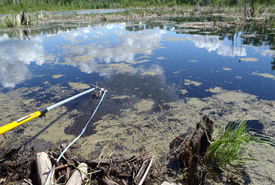Jenet Dooley-ABMI, Wetland Ecologist

Collection of water samples that eDNA will be extracted from (Photo by Amanda Schmidt ABMI/Innotech)
ABMI eDNA Pilot
ABMI initiated the use of environmental DNA (eDNA) sampling, a promising technology for biological monitoring, with a pilot study in 2020–21. We paired eDNA sampling and automatic recording units (ARUs) at four wetlands in the Edmonton area. We want to compare the abilities of the two methods to detect amphibians.
What is the problem you are looking to solve or the question you are looking to answer?
ABMI continuously improves our monitor program by exploring new technology that is cost and time effective and produces scientifically sound data. For example, we were an early adopter of ARUs and currently use them across the province to collect data on birds and amphibians. eDNA methods are able to detect the presence of species from small water samples or soil samples without the need to collect or identify specimens, timely and costly activities. The objective of this pilot study is to compare the detection ability of eDNA methods to our current monitoring method, acoustic ARUs. We see the potential in eDNA methods and want to make sure that we are keeping up with advancements. The design of our study will also contribute to the knowledge base about eDNA collection methods.
What is the impact you are hoping to achieve in Alberta (or beyond) with the project you are involved with?
eDNA is a promising method to efficiently capture species occurrence data from a location through passive sampling. This saves time in the field compared to traditional observational studies.
At its core, eDNA monitoring identifies species’ DNA from an environmental sample. A species’ genome is not constant over time, and spatially distant populations of a species can vary. This can complicate eDNA monitoring if the DNA records used to identify species don’t match the local population.
Amphibian eDNA work in the province has established monitoring methods for specific species and regions. For example, northern leopard frog work in the south by Lea Randall at the Calgary Zoo and Brian Eaton’s work in central Alberta. In order for eDNA monitoring to be successful over large landscapes like Alberta, researchers will need to collaborate and share successful monitoring methods. Our hope is that we can help facilitate this collaboration for all taxa currently part of our program (birds, mammals, vascular plants, mites, aquatic invertebrates, etc.) across Alberta. This pilot project is kicking off these efforts through the exploration of amphibian monitoring eDNA methods.
What will you learn from your project?
The ability to detect eDNA in aquatic environments is maximized when you collect your samples close in time and space to the active organisms. We are trying to determine where and when we should collect eDNA samples to maximize the detection of amphibians.
The paired eDNA and ARU sampling will help us determine (a) if the species detected are the same for the two methods, and (b) if the species detected via eDNA change over time. We will assess if there is an optimal sampling window for eDNA. Further, an advantage of using eDNA and ARUs is that eDNA will be sensitive to any non-calling individuals, enabling us to capture the full amphibian community, and may be more robust to varied calling behaviour, which has been known to drive high variability in amphibian detection across years.
What is the project’s biggest achievement to date, or what are you looking forward to achieving in the coming months?
We originally wanted to sample at five wetlands, but, at the last minute, we realized that one of them didn’t meet our site requirements. We were able to work with Brian Eaton’s team at Innotech Alberta to come up with a new sampling methodology that incorporates composite samples to try out at one of the wetlands in addition to the original sampling methodology.
The sampling methodology builds off of work that Brian’s team has done to improve eDNA sampling techniques. We were able to make an opportunity out of unfortunate news and will hopefully gain useful information about this new sampling technique. I am looking forward to receiving the results.
How can this project benefit NCC’s work and support other conservation initiatives?
Traditional amphibian monitoring techniques are costly. They require many staff hours for several field visits, specialized equipment and complicated logistics to align surveys with weather patterns (amphibian activity peaks). Even with these considerations, some species are difficult to observe through traditional methods because they are sensitive to disturbance and/or don’t use vocal calls. eDNA could help solve these problems through passive sampling, which could improve data collection and decrease costs.
Our project will contribute to the development of eDNA methods for the Edmonton area and beyond. Our work will help make successful eDNA monitoring programs accessible to more groups, including conservation organizations wanting species information about conservation properties.
This project is an opportunity for ABMI and NCC to establish a partnership on eDNA work and facilitate further eDNA testing, producing more shared knowledge. Through this project, we will produce species lists for the NCC properties that are a part of the project and share insights on the effectiveness of two remote methods to create species lists for future and current properties.
What is your favourite part of the project you are working on?
My favourite part of this project is all of the connections we have been able to make. ABMI is relatively new to amphibian monitoring and has been able to (remotely) meet with many experts studying amphibians in Alberta this year. Through this project, we have been able to establish this relationship with NCC. Brian’s lab at Innotech Alberta has provided expertise and shared knowledge about eDNA. The ABMI monitoring centre (also housed at Innotech) worked closely with Brian’s team to develop and employ the eDNA sampling methods.
What gets you excited about the species, habitat or theme your project is investigating?
Amphibians are a great taxon to connect with the public about. They’re very charismatic and mostly rely on vocal communication, an easy way to identify them when you are out exploring wetlands. I think they are an accessible group of wildlife for people to learn more about because there are only 10 species in Alberta.




